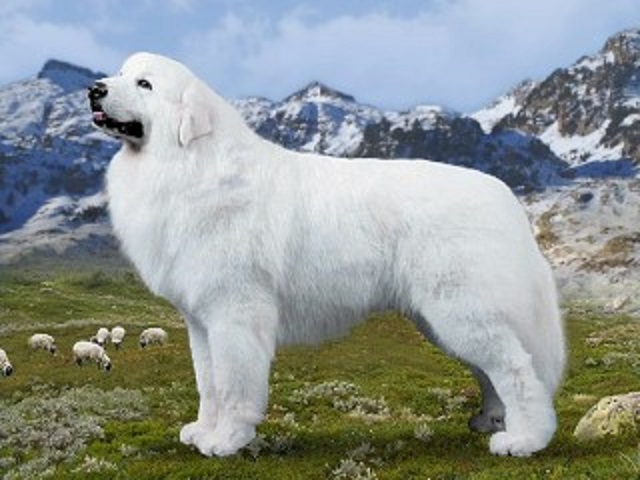
Great Pyrenees

Navigate through the tabs
Navigate through the tabs below to view the breed's info of your interest.
The breed's info is divided in four sections; namely:
the breed's history ,
the breed's main stats ,
the dog's potential health issues
and finally, how the breed scored in 26 different categories.
All the above information should give you a respectively good overview for the dog of your interest.
Dog Breed's Main Info
The Breed's History:
The sheep-guarding Great Pyrenees originated in the Pyrenees Mountains, which form a natural border between France and Spain. He's known by different names: Great Pyrenees in the United States and Canada, the Pyrenean Mountain Dog in the United Kingdom and most of Europe.
His ancestry is believed to date back ten to eleven thousand years to dogs who originated in Asia Minor. His ancestors are thought to have come to the Pyrenees Mountains sometime around 3000 B.C.
There the breed was developed to create a dog who would aid shepherds.
At first, the Great Pyrenees was considered to be a dog owned by peasants. But in 1675, the Dauphin in the court of King Louis XIV declared that the Great Pyrenees was the Royal Dog of France.
This prompted the French nobility to acquire Great Pyrenees and use them to guard estates.
The first Great Pyrenees to be imported to North America went to Newfoundland, Canada. There the breed is attributed with creating the Landseer Newfoundlands, after crossbreedings between the Great Pyrenees and the Newfoundland.
Throughout the 1800s, the breed gained popularity throughout England, Europe, and the United States. He was introduced into the St. Bernard's breeding program in Switzerland in an effort to reestablish the numbers of dogs at the famous hospice where the St. Bernard originated.
In the Pyr's homeland, however, the breed began to deteriorate due to unscrupulous breeding practices.
The two World Wars took a toll on all dog breeding; luckily several Great Pyrenees were imported to the United States before the European continent was effectively closed due to World War II.
After the war, breeders began efforts to restore the breed to its former glory, and today the Great Pyrenees is a much-loved and admired dog.
Country of Origin:
France / Spain
Breed Group:
Working
Height:
2 feet, 1 inch. to 2 feet, 8 inch. (63,5 to 81,28 cm)
Weight:
85 to 160 pounds (38,55 to 72,58 Kg)
Life Span:
10 to 12 years
Potential Health Issues:
Gastric Torsion,
Hip Dysplasia,
Bone Care,
Addison's Disease,
Patellar Luxation,
Cataracts,
Entropion,
Anesthesia Sensitivity,
Elbow Dysplasia
Adaptability
Apartment Living:
First Time Owners:
Sensitivity:
Being Alone:
Cold Weather:
Hot Weather:
Friendliness
Affection With Family:
With Kids:
With Dogs:
With Strangers:
Health and Grooming
Shedding:
Drooling:
Easy To Groom:
Overall Health:
Weight Gain Potential:
Size:
Training
Easiness:
Intelligence:
Mouthiness:
Prey Drive:
Barking or Howling:
Wanderlust:
Need For Exercise
Energy Level:
Intensity:
Exercise Needs:
Playfulness:
Our Mobile Application
Check out Our Mobile Application "Dog Breeds Central"
